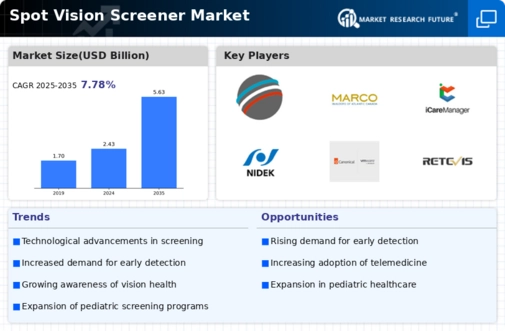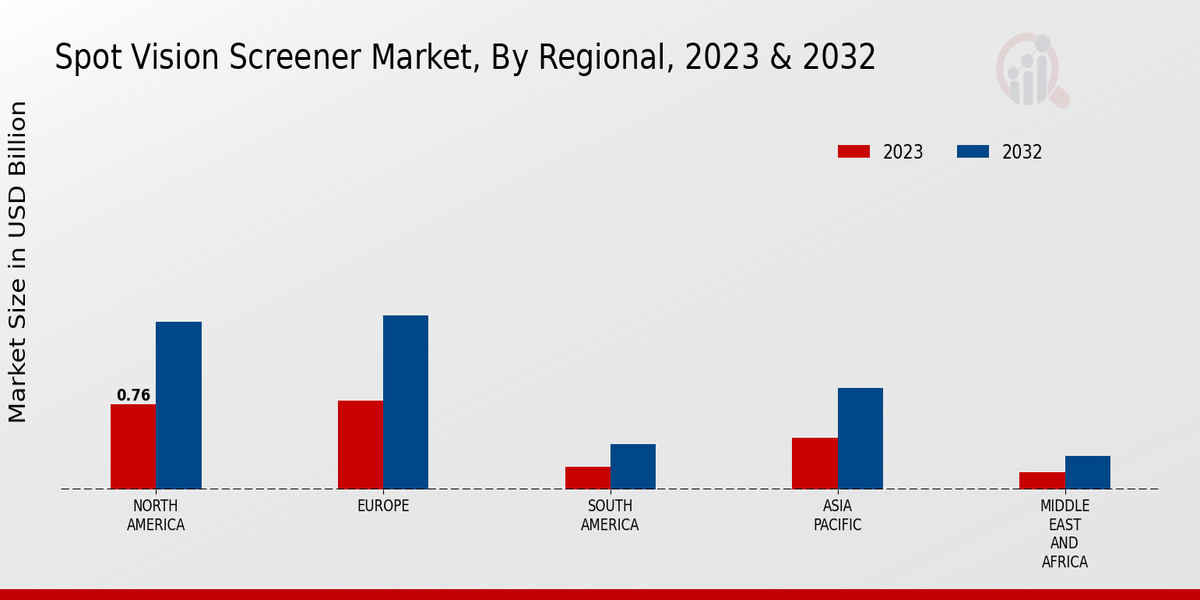Market Growth Projections
The Global Spot Vision Screener Market Industry is poised for substantial growth, with projections indicating a market value of 5.63 USD Billion by 2035. This growth trajectory reflects a compound annual growth rate of 7.94% from 2025 to 2035. Factors contributing to this expansion include technological advancements, increasing prevalence of vision disorders, and supportive government initiatives. As the demand for efficient and accurate vision screening solutions rises, the market is likely to witness significant developments. The ongoing evolution of screening technologies and the emphasis on preventive healthcare will further enhance the market's prospects.
Rising Geriatric Population
The increase in the geriatric population worldwide is a crucial factor influencing the Global Spot Vision Screener Market Industry. Older adults are more susceptible to various vision disorders, necessitating regular screening and monitoring. As the global population ages, healthcare systems are focusing on providing comprehensive eye care services to this demographic. The Spot Vision Screener's ability to facilitate quick assessments makes it an attractive option for geriatric care providers. This demographic shift is expected to drive market growth, contributing to the anticipated market value of 2.43 USD Billion in 2024, as healthcare providers seek effective solutions for vision screening.
Growing Awareness of Eye Health
The growing awareness of eye health among the global population is a significant driver for the Global Spot Vision Screener Market Industry. Educational campaigns and outreach programs are informing individuals about the importance of regular vision screenings. This heightened awareness is leading to increased demand for efficient screening solutions, particularly in schools and community health settings. As parents and educators recognize the critical role of early detection in preventing long-term vision issues, the adoption of the Spot Vision Screener is likely to rise. This trend aligns with the projected market growth, reinforcing the need for accessible vision screening technologies.
Government Initiatives and Funding
Government initiatives aimed at improving eye health and vision screening programs are pivotal for the Global Spot Vision Screener Market Industry. Many countries are implementing policies to promote regular eye examinations, particularly for children. Funding for vision screening programs is increasing, enabling healthcare facilities to acquire advanced screening technologies. For example, public health campaigns encourage early detection of vision problems, which is likely to enhance the adoption of devices like the Spot Vision Screener. This supportive environment is expected to contribute to a compound annual growth rate of 7.94% from 2025 to 2035, reflecting the market's potential.
Increasing Prevalence of Vision Disorders
The rising incidence of vision disorders globally drives the Global Spot Vision Screener Market Industry. According to health statistics, millions of individuals suffer from refractive errors, which necessitate early detection and intervention. The Spot Vision Screener, with its ability to quickly assess vision issues in children and adults, is becoming increasingly essential. As awareness of eye health grows, healthcare providers are more inclined to adopt advanced screening technologies. This trend is likely to contribute to the market's growth, with projections indicating a market value of 2.43 USD Billion in 2024, reflecting the urgent need for effective vision screening solutions.
Technological Advancements in Screening Devices
Technological innovations in vision screening devices are significantly impacting the Global Spot Vision Screener Market Industry. The introduction of automated and portable screening solutions enhances the accuracy and efficiency of vision assessments. These advancements allow for quicker diagnoses and better patient outcomes, particularly in pediatric populations. For instance, the integration of artificial intelligence in screening processes is expected to improve detection rates of vision impairments. As these technologies evolve, the market is anticipated to expand, with a projected value of 5.63 USD Billion by 2035, indicating a robust demand for cutting-edge vision screening tools.




















Leave a Comment